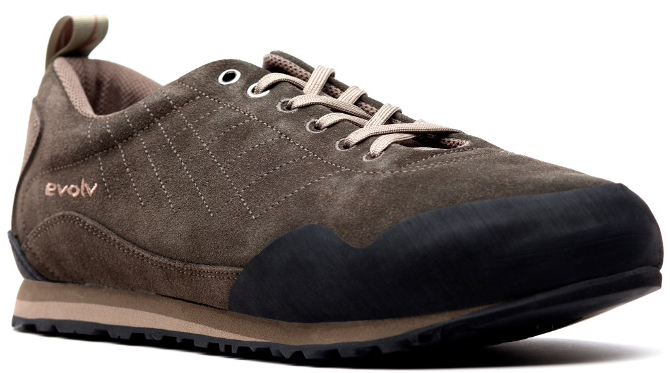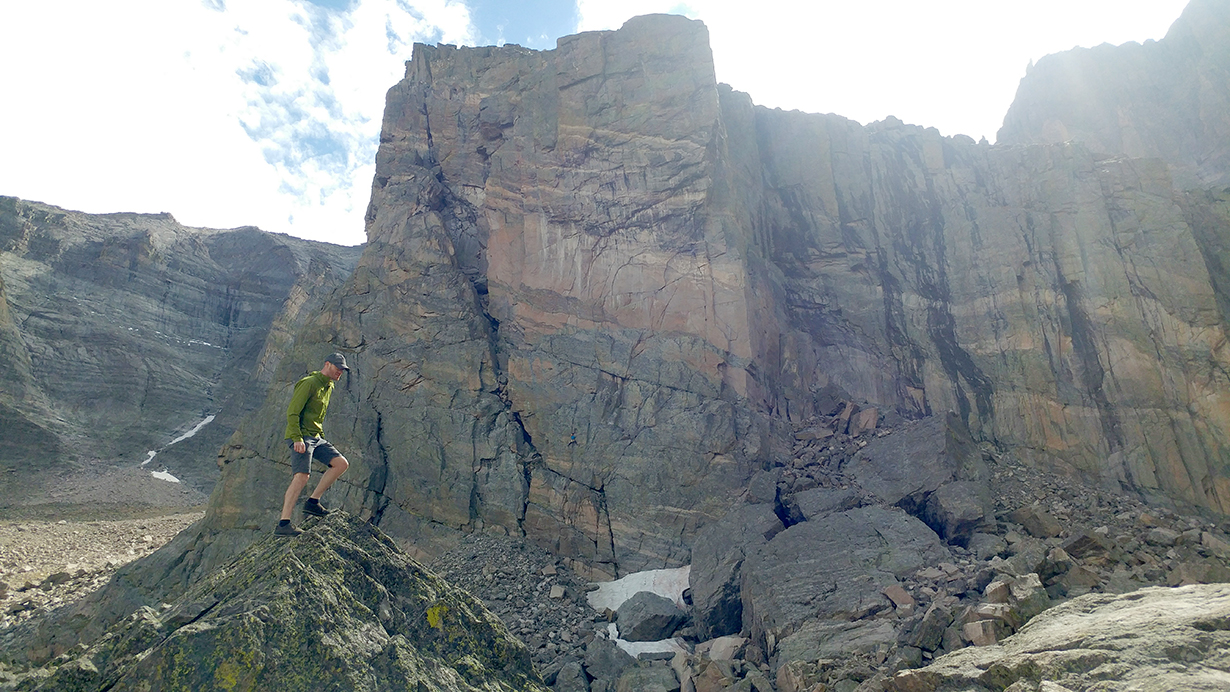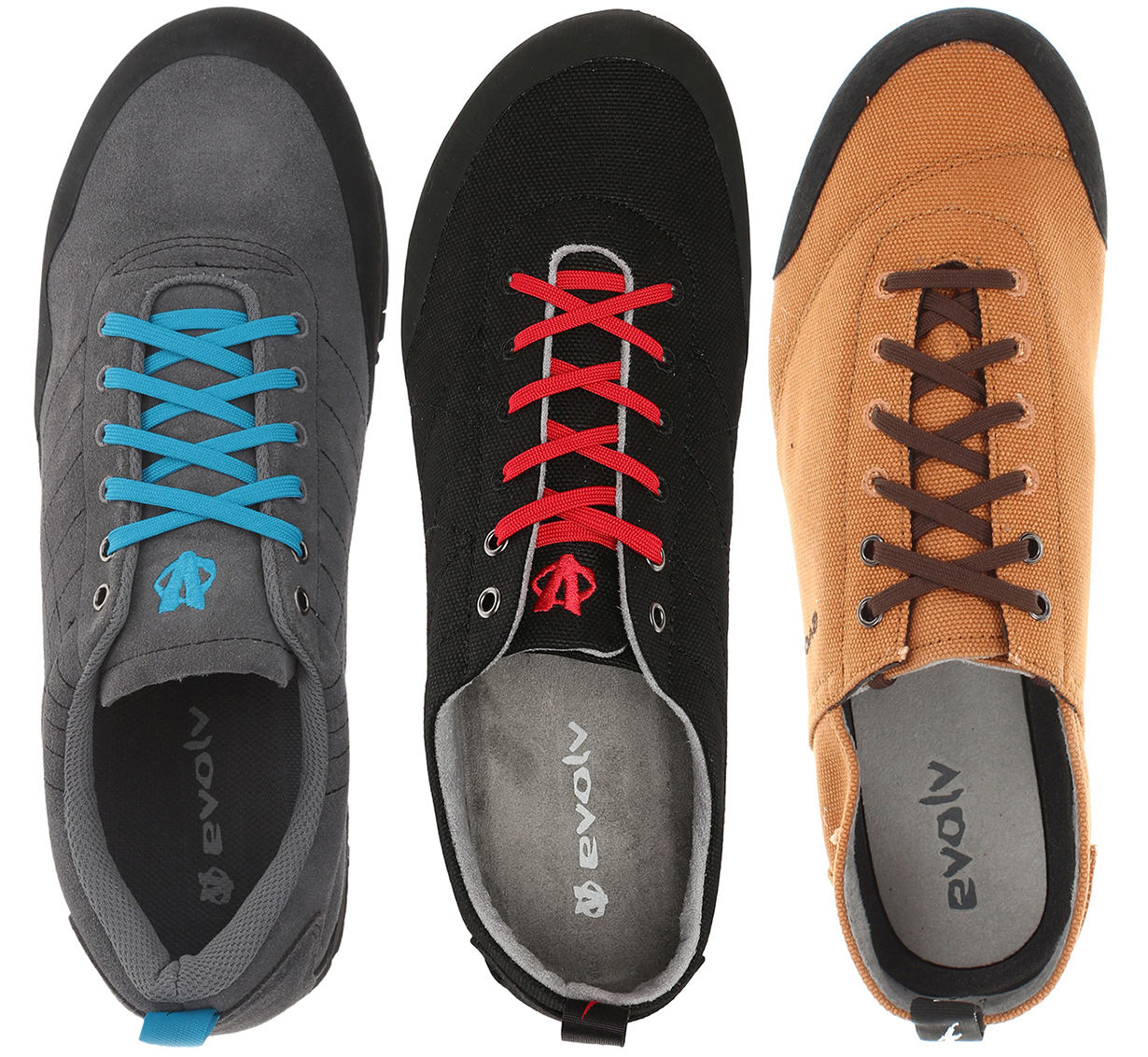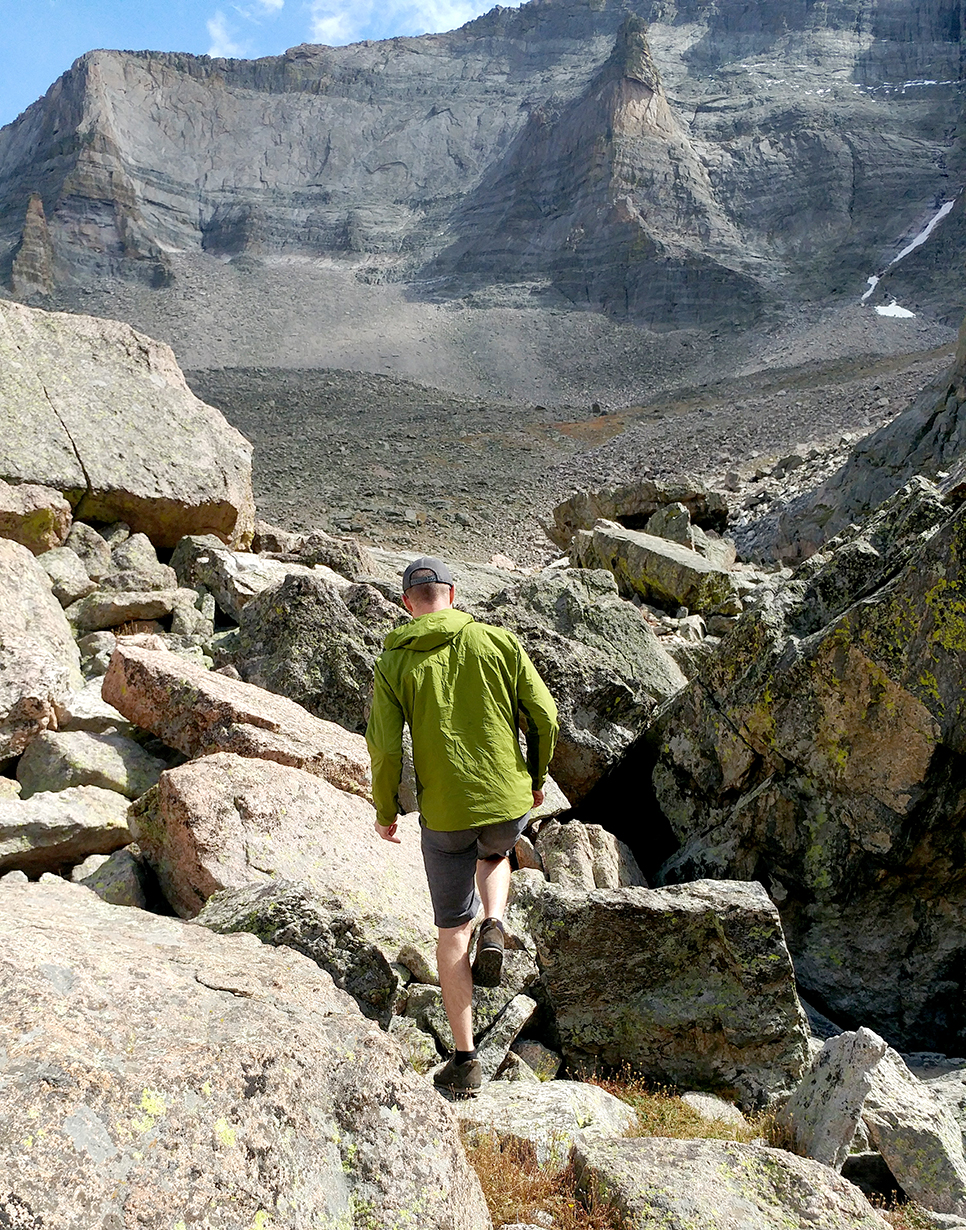
Evolv Zender
Stated Weight per Shoe (size 9): 198 g / 7 oz
Stated Features:
- Microfiber lined memory foam insole for lasting comfort
- Soft microporous EVA midsole
- Ultra-light
- Full leather upper
MSRP: $99
Size Tested: 13
Test Locations: Rocky Mountain National Park, Estes Park, & Independence Pass, CO; Vedauwoo, WY; Rumney, NH
Days Tested: 10
Intro
As the name implies, “approach shoes” are designed to handle the varied terrain one might encounter en route to a climb. This could include everything from packed trails at a nearby crag, to technical and exposed scrambling leading up to an alpine objective. And as a result, the current crop of approach shoes varies just as widely, and ranges from stiff, technical models that would be at home on long, hard ridgelines, to those resembling trail runners with sticky soles, to more casual shoes that wouldn’t look out of place in town.
So is the best approach shoe the one that’s best at hard scrambling? Is it the one that suits the most common hiking or approach trails, even if they aren’t very technical? The “approach” label is getting slapped on more and more shoes, so it’s increasingly important to figure out where exactly a particular shoe fits on this spectrum.
The Zender is a member of Evolv’s Cruzer family of what they’re calling “performance lifestyle” shoes (which also includes the Cruzer Classic and Cruzer Psyche) and the Zender is designed with more of a focus on hiking and all-around comfort than the other two. It has a casual look and feel, and could conceivably be confused for a skate shoe. But it’s built on a trail-running last and has the same sticky rubber as the other Cruzer approach shoes.
So is the Zender more of a lifestyle shoe (as the look would imply), or is it more defined by its trail-running last and sticky rubber? We’ll address those questions and offer a number of comparisons in order to get clear on what the Zender is and where it best performs.
Construction, Weight, and Comparisons
If the Cruzer Psyche can be thought of as a more hiking-focused Cruzer Classic, then you can think of the Zender as a shoe that is a few more steps closer to a generalist hiking and approach shoe (and the emphasis here is more on the hiking aspects of “approach,” rather than the technical scrambling).
The primary difference between these shoes is the last — the Zender’s last has a similarly roomy toe box to the Psyche, but with more straight-on geometry. The Zender’s lack of asymmetry encourages you to strike with your heel as opposed to your forefoot, and helps make the Zender feel a little more like a traditional low-cut hiking shoe or even a trail runner (at least in shape) compared to the Psyche, and much more so than the more minimal Cruzer Classic.
Another key difference between the three shoes is the upper — the Zender’s upper is made of leather rather than the canvas on the Classic and Psyche (though it retains the canvas liner found in the Psyche). The Zender also includes an extra strip of leather around the base of the upper for increased support. These two differences further distance the Zender from the Classic and Psyche, and more into the realm of general hiking shoes.

Despite these differences, the Zender still scrambles nearly as well as the Psyche. If you wear them back-to-back you can feel the difference in asymmetry mentioned previously, but it’s not a world of difference — both shoes still have a similar medium-volume fit and medium-stiff midsole that make it hard to forget that they’re closely related.
At 198 g / 7 oz per shoe (in a size 9), the Zender is slightly heavier than the Psyche (187 g / 6.6 oz), yet still less than half the weight of other approach shoes such as the Five Ten Guide Tennie (407 g / 14.4 oz), La Sportiva BoulderX (481 g / 16.97 oz), and Salewa Mountain Trainer (510 g / 17.99 oz).
Last and Fit
The Zender is built on Evolv’s latest trail-running last. While the straight-on shape of the Zender is preferable for trail running compared to more asymmetrical shoes, I’d hesitate to endorse the Zender as a primary-use trail runner, if only because of the solid leather upper — it doesn’t breathe nearly as well as modern, mesh-adorned trail runners, and is heavier for the same reason. That said, if what you really want is a hiking-focused approach shoe and you do some running here and there but don’t want to buy two shoes, the Zender could be worth a look.

If you read our Cruzer Psyche review, you’ll notice that I complained about the looser fit and soft upper of the Psyche, which allowed for too much lateral foot movement inside the shoe, especially while scrambling. This compromised some stability on uneven terrain and detracted from the precision of the shoe. The same is true of the Zender. While the upper has some padding absent on the Psyche and is generally a bit more built-up overall, the Zender’s upper remains quite soft, and the shoe ultimately suffers from the same lack of precision on difficult scrambles.
Technical Scrambling and Best Use
Like the Psyche, the Zender’s features and construction aim to create a more comfortable shoe, one that’s capable of managing much longer days on the trail compared to the Cruzer Classic. The decrease in precision might be an issue for certain objectives that involve a lot of technical 4th and 5th class scrambling, but for hikers and climbers that spend much of their time on more moderate terrain, I’d have no problem recommending the Zender. To put this in a broader perspective, the Zender’s scrambling ability resembles a lightweight, stripped-down version of the Five Ten Guide Tennie, but with a softer, more flexible upper.

If you think you might mourn the loss of some capability on technical terrain, you might consider looking at the Salewa Mountain Trainer or SCARPA Crux if you prefer a stiffer shoe, or the Cruzer Classic if you need something lighter and more minimal.
However, for hiking with the occasional patch of scrambling or boulder hopping, the Zender is wonderful. It doubles down on the Cruzer Psyche’s focus on comfort with the addition of some padding around the ankle while still preserving the former’s featherweight nature.
Price
At $100, the Zender is $25 more expensive than the Cruzer Classic and Psyche, but still significantly cheaper than most other approach shoes. The next best thing in terms of price is the $110 Sportiva BoulderX, with the Five Ten Guide Tennie coming in at $140, and most other shoes beyond that. So, relative to the rest of the competition, the Zender is a great value.
On the other hand, the Zender is still 33% more expensive than the Psyche, so ask yourself what it is that you’re looking for (and really need) in an approach shoe. The Zender’s leather upper is nice and there’s a bit more padding, and this comes without much more of a hit on the price tag compared to the Psyche. So the extra comfort is likely worth it if you’re looking for a shoe for long hikes, but since their on-trail performance is pretty similar, I have to give the edge to the Psyche when it comes to overall value.
Bottom Line
The Evolv Zender shares characteristics of both hiking / approach and casual, around-town footwear, and blends them better than any other approach shoe I’ve used in the past. Like its close cousin, the Cruzer Psyche, the Zender excels at long, single-day hikes and scrambles. The emphasis on comfort makes the Zender less suited for the most technical scrambles, but on the flip side, it’s more comfortable on all the other mellower terrain you usually encounter on most approaches.
The leather upper of the Zender gives you some protection from water and wind if you’re doing anything in the alpine, and I’ve been very impressed with its comfort and performance given its remarkably low weight. Much like the Psyche, the Zender looks even better once price is factored in, though you should consider whether or not the Psyche (which is even cheaper than the Zender) will suit your needs just as well.
